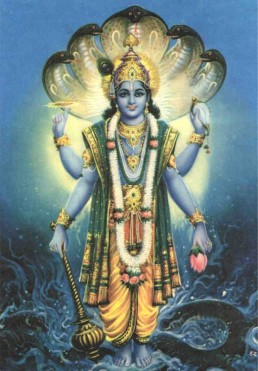Reminiscent of the casual picture of the “Peepal-tree” brought up in the Kathopanishad (VI-1), here Vyasa exhaustively paints the Tree-of-life and shows its relationship with the Infinite. If the Spirit be one-without-a-second, out of this one Consciousness how did the world-of-matter — constituted of the body and its perceptions, the mind and its feelings, the intellect and its thoughts — arise? Even if it has so risen up, what nourishes it and sustains it? What exactly is the relationship between God, the CREATOR, and the world, the CREATED — the Infinite and the finite? These are some of the questions that generally rise up in any human intellect, once it is set to contemplate upon life.
The picture of the “Peepal-tree” unveiled in these three stanzas serves as a beautiful allegory of the entire spiritual concept expounded in this chapter.
Ashwattha is botanically known as Ficus Religiosa, popularly called the Peepal-tree, which, according to some, has gathered its name “because horses used to stand under its shade (Ashwattha).” According to Shankara, this tree has been chosen to represent the entire cosmos because of its derivative meaning — Shwa means “tomorrow”; Stha means “that which remains”; therefore: A-shwattha: “that which will NOT remain the same till tomorrow.” In short, the word indicates the ephemeral, the ever-changing, world of the phenomena.
It is described here that the Ashwattha-tree has its roots “up” (Urdhwa). Accepting directly the literal meaning, we have got some spiritually absurd, religiously mischievous, and aesthetically ugly ‘pictures’ of this Tree-of-Samsara, painted by some illiterate artists, and made easily available in the Indian markets. It is an insult to the mighty majesty of this scriptural picture.
According to Anandagiri, Samsara is represented as a tree (Vriksha) because of the etymological meaning of the Sanskrit term, Vriksha: “that which can be cut down.” The experiences of change and sorrow which the world-of-plurality gives us can be totally ended through detachment. The Tree-of-Multiplicity that has seemingly sprung forth from the Infinite Consciousness Divine, can be cut down by shifting our attention from the tree to the Divine.
Luckily, we who are educated in modern universities, have a similar use of the term “tree” in our history text-books. The ‘family trees’ of kings and dynasties are, without any exception, shown as branching down from their ancestral ‘source.’ Similarly, the Tree-of-Samsara has its roots UP in the Divine Consciousness. A tree holds itself up and gets nourished by its roots; similarly, the “experiences” of change, and the “experiencer” of them, are all established in the Infinite and draw their sustenance from It alone.”Even then,” many of our friends doubt, “why is the word ‘UP’ (Urdhwa) used?” It is used here in the same connotation as we use the term ‘up’ in our every-day expressions, like ‘HIGH-command’: ‘HIGHER-officials’: ‘TOP-men’: ‘UPPER-class’: ‘HIGH-class jewellery’ etc. In all these cases, by the term HIGH or UP or TOP, no geometrical elevation is indicated, but it indicates a superiority, a greater nobility, or value. Psychologically, it is natural for man to concede, for the subtler and the diviner, a HIGHER place of reverence and to consider the grosser and the devilish as belonging to a LOWER status. The Perfect is the Highest Consciousness, illumined and vitalised by which alone can the body-mind-intellect equipment experience its world of “perception-emotion-thought.” Naturally, therefore, the world-of-plurality is allegorically pictured here as the fig-tree — arising from and sustained by the Higher Consciousness,
the Reality.
This world-of-change (Ashwattha) is considered here as eternal (Avyaya), only in a relative sense. Any peepal-tree in any village must have observed many generations playing and growing up under its shade, and thus, with reference to man’s average age, the fig-tree can be considered as RELATIVELY eternal. Similarly, with reference to the generations that grow, conceive, plan, strive, achieve and die away, the world itself can be considered as RELATIVELY immortal.
For this tree-of-life “THE VEDAS THEMSELVES ARE THE LEAVES” — Veda means ‘knowledge.’ Knowledge does bring forth a greater spurt of dynamism of life into the world. In comparison with the modern world — with its colossal endeavours, mighty achievements, and superhuman aspirations — the ancient generations were, relatively speaking, not even alive. More the knowledge a generation acquires, clearer becomes its vision of a greater future and diviner possibilities, and therefore, more is the amount of effort put forth by it to achieve the perceived goal. Now to compare Veda-‘knowledge,’ to the leaves of the “Tree” is not quite inappropriate. Leaves are areas from which the water contents get evaporated in all trees, and this, in its turn, creates the ‘osmotic-pressure’ in the roots and facilitates the roots to draw more quantity of nourishment from the earth. Cut down the leaves of a tree and its growth is immediately stunted; the larger the number of branches and leaves, the greater is the tree’s dimension and growth. Where there is greater knowledge, there we are sure to find a greater flare of manifest-life.
HE WHO KNOWS IT, IS A KNOWER OF THE VEDA — He alone, who has realised not only the Ashwattha-tree, but also the Higher, from which it derives its existence, is the one who has fulfilled his knowledge of the Vedas. The Vedas indicate the One Eternal Principle from which all the realms of experience have sprung. Neither pure science, nor mere devotion, can achieve the Truth of perfect knowledge, is the conclusion of the Geeta. Knowledge is perfect only when we know of the here and the hereafter, of the finite and the Infinite, of the created and the Creator. All the rest of the pursuits of knowledge, however spectacular they might be, are, at best, only one-sided views of the whole Truth. The Man-of-Perfect-‘Wisdom,’ as conceived by the Vedas, is the knower of both the PERISHABLE and the IMPERISHABLE; and such a man alone is recognised by Krishna as the Vedavit — knower of the Vedas.
NOW FOLLOWS ANOTHER FIGURATIVE RE-PRESENTATION OF THE MEMBERS OF THIS TREE OF SAMSARA:

